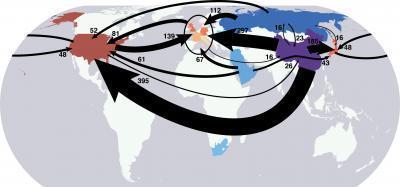A new study by scientists at the Carnegie Institution finds that over a third of carbon dioxide emissions associated with consumption of goods and services in many developed countries are actually emitted outside their borders. Some countries, such as Switzerland, "outsource" over half of their carbon dioxide emissions, primarily to developing countries. The study finds that, per person, about 2.5 tons of carbon dioxide are consumed in the U.S. but produced somewhere else. For Europeans, the figure can exceed four tons per person. Most of these emissions are outsourced to developing countries, especially China.

China is by far the largest "exporter" of carbon dioxide emissions, as seen in this map of the net flow of emissions embodied in trade among the major exporting and importing countries. Arrows indicate direction and magnitude of flow; numbers are megatons (millions of tons). (Credit: Steven Davis/Carnegie Institution for Science)
"Instead of looking at carbon dioxide emissions only in terms of what is released inside our borders, we also looked at the amount of carbon dioxide released during the production of the things that we consume," says co-author Ken Caldeira, a researcher in the Carnegie Institution's Department of Global Ecology.
Caldeira and lead author Steven Davis, also at Carnegie, used published trade data from 2004 to create a global model of the flow of products across 57 industry sectors and 113 countries or regions. By allocating carbon emissions to particular products and sources, the researchers were able to calculate the net emissions "imported" or "exported" by specific countries.
"Just like the electricity that you use in your home probably causes CO2 emissions at a coal-burning power plant somewhere else, we found that the products imported by the developed countries of western Europe, Japan, and the United States cause substantial emissions in other countries, especially China," says Davis. "On the flip side, nearly a quarter of the emissions produced in China are ultimately exported."
Over a third of the carbon dioxide emissions linked to good and services consumed in many European countries actually occurred elsewhere, the researchers found. In Switzerland and several other small countries, outsourced emissions exceeded the amount of carbon dioxide emitted within national borders.
The United States is both a major importer and a major exporter of emissions embodied in trade. The net result is that the U.S. outsources about 11% of total consumption-based emissions, primarily to the developing world.
The researchers point out that regional climate policy needs to take into account emissions embodied in trade, not just domestic emissions.
"Our analysis of the carbon dioxide emissions associated with consumption in each country just states the facts," says Caldeira. "This could be taken into consideration when developing emissions targets for these countries, but that's a decision for policy-makers. One implication of emissions outsourcing is that a lot of the consumer products that we think of as being relatively carbon-free may in fact be associated with significant carbon dioxide emissions."
"Where CO2 emissions occur doesn't matter to the climate system," adds Davis. "Effective policy must have global scope. To the extent that constraints on developing countries' emissions are the major impediment to effective international climate policy, allocating responsibility for some portion of these emissions to final consumers elsewhere may represent an opportunity for compromise."
The report is published online in the March 1, 2010 Proceedings of the National Academy of Sciences.
(The Center for Earth Observation and Digital Earth, The Lanzhou Branch of the National Science Library / The Scientific Information Center for Resources and Environment,Chinese Academy of Sciences)